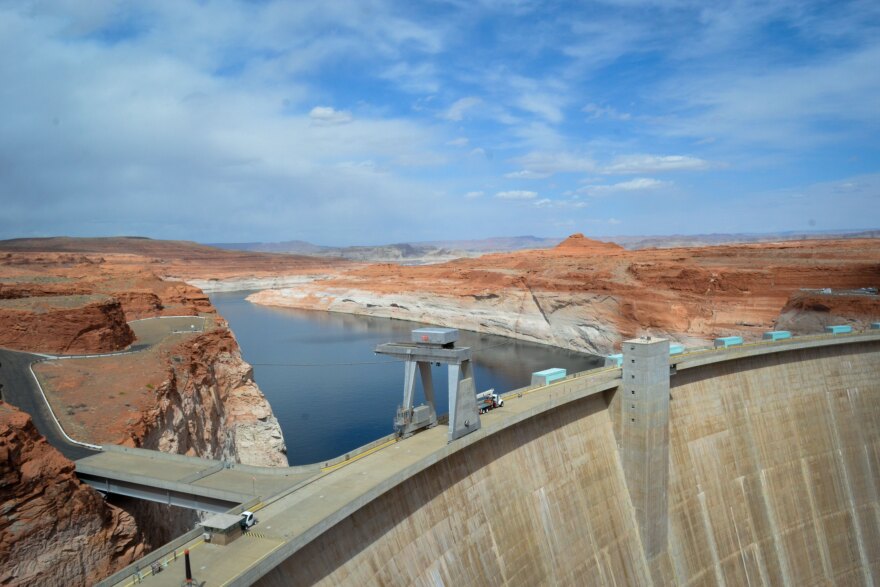Snowmelt from Utah’s wet winter filled up reservoirs across the state. That’s great news for communities recovering from years of severe drought, but it might be bad news for the dams holding those reservoirs.
Many dams, such as the Glen Canyon Dam at Lake Powell, were designed to use water pressure from a full reservoir to keep their connection to bedrock tight. But years of drought shrank reservoir levels to new lows and exposed dam structures to risks that their designers might not have imagined.
Steven Hawley, an Oregon-based author who writes about dams and rivers, said climate change is fueling increasingly extreme cycles of dry and wet weather, and we don’t yet know the full extent of how that will impact dams’ structural integrity.
“What’s daunting about this is that I don’t think anybody knows the answer to that question,” Hawley said. ”These structures were designed under the assumption that the water level wouldn’t ever fluctuate the way it’s fluctuating now.”
On top of that, many dams are already at heightened risk of failing because of their age.
Concrete structures have a lifespan of roughly 60 years, Hawley said. Glen Canyon Dam’s last bit of concrete was put into place 60 years ago this September. The concrete at Flaming Gorge Dam in northeast Utah is a few months older than that.
“They are ticking time bombs in many ways,” Hawley said.
Over the past several weeks, many of Utah’s reservoirs have filled up to their highest levels in years. That put Utah’s assistant engineer of dam safety, Everett Taylor, on alert. He was concerned whether the state’s dams were ready to handle the record snowpack flowing down this spring.
“I feel really good about the state of things today,” Taylor said. “If you asked me that same question in March, there was a lot of question marks.”
Utah has seen its share of dam disasters over the years. The 75-foot-tall Little Deer Creek Dam gave way in 1963 causing extensive damage in northeast Utah and claiming the life of a four-year-old boy. The failure of a dam on the Quail Creek Reservoir near St. George forced 1,500 people to evacuate in 1989.

Today, Utah has a total of 223 dams that the U.S. Army Corps of Engineers classifies as high hazard dams, meaning they’d pose a significant threat to people and property downstream if they failed. The state lists 105 of those dams as priorities in need of rehabilitation.
But the process for actually getting dams fixed up is slow going. Only 24 of those 105 priority dams are currently in the process of having their rehabs designed or constructed.
The two main roadblocks to getting Utah’s dams shored up, Taylor said, are the usual suspects: Not enough money and not enough workers. Only four of those 105 priority projects currently have funding. The state estimates that it takes an average of $4.5 million to complete each dam rehab project.
And Taylor said even if Utah suddenly had enough money to finish all the projects on its list, there wouldn’t be enough engineers and laborers to carry out the work.
Another tricky thing is that the state owns hardly any of Utah’s dams. Most are privately owned, either by individuals or by groups, such as irrigation companies, conservation districts or municipalities. But the state inspects dam conditions annually, Taylor said, and tells owners if they need to do maintenance.
This spring, Utah sent letters to dam owners encouraging them to prepare for the incoming wave of snowmelt. The most common way to do that, Taylor said, is to release water from a dam’s low level outlet — basically, the bathtub drain toward the bottom of the dam — to lower reservoir levels and make room for runoff.
“We are happy to have them fill up,” Taylor said. “(But) we do watch them to make sure that we're not putting undue stresses on them.”
The enormous expenses associated with keeping these large, aging structures up to modern safety standards, Hawley said, creates a massive backlog of maintenance tasks at dams nationwide. But the real problem, he said, isn’t an engineering conundrum. It’s a philosophical one.
Society and the environment have gone through some big changes in the decades since many of America’s dams have been built. In some cases, he said, it may make more sense to take down a dam rather than keep it going in perpetuity.
The time is right, Hawley said, for states and the federal government to review which dams are still providing economic or environmental benefits and which ones have lived out their useful lifespans.
“The answer to that question — whatever it is — costs a lot of money,” Hawley said. “And right now, that money isn't being spent.”





